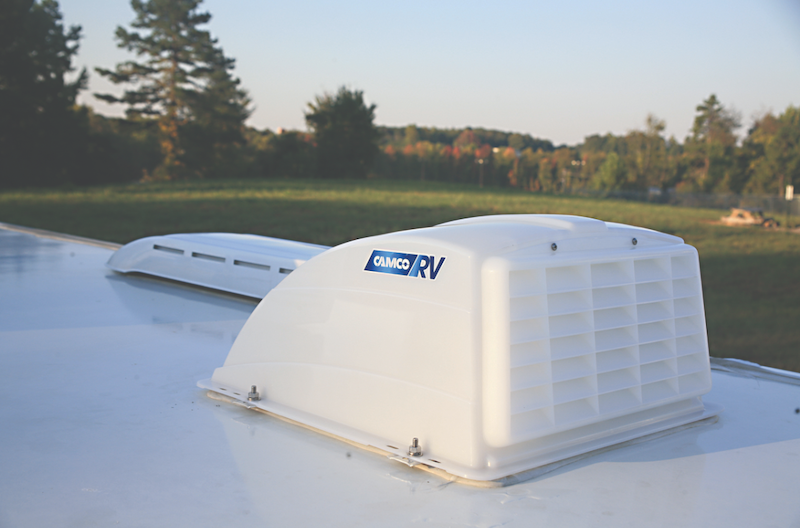How to prevent tire blowouts on your RV
Here are the steps you can take, both before and during your trip, to ensure that the risk of your RV suffering a tire blowout is kept to a minimum.
Before your trip
Store your RV in a way that prevents dry rotting of tires
Tires are designed to be ridden regularly. If they go months without being in motion, then they can become particularly susceptible to dry rot. Dry rot can cause the rubber in tires to become very hard and brittle, making them more susceptible to blowouts when being ridden on.
The biggest contributor to dry rotting in tires is direct sunlight. UV strips away some of the resins in tires that hold in their moisture. Keeping your RV indoors and out of direct sunlight (UVA rays can pass through windows) should go a long way to slowing down the deterioration of tires.
If you have no option but to keep your RV outdoors for long periods of time, then it’s worth keeping it covered with an opaque, waterproof covering to protect your tires from direct sunlight and oxidization from water.
Know the age of your tires, and make sure that they do not exceed six years
The rubber that tires are made out of will naturally deteriorate over time, regardless of how frequently or infrequently they are ridden. You therefore should not drive on tires that are six years old or older.
You can tell the year that a tire was manufactured by looking at the numbers on the sidewall of the tire. Where these numbers are on a tire’s sidewall can vary from make to make, and there is a video below that can give you an overview of how you can find this information.
Tires that are over six years old should be replaced with tires of the same make and size that originally came with the RV.
Make sure your RV is not overweight before you set off
All vehicles have a maximum weight that they are designed to carry without the risk of damage to their tires. Although RVs are designed with the purpose of carrying more than your everyday car, they too will have a maximum safe weight.
You can find out this maximum weight in your vehicle’s manual. The figure that you want to look out for is the Gross Vehicle Weight Rating (GVWR). This figure gives you the maximum weight a vehicle can carry, including both the weight of the vehicle itself and everything that is in it.
If you are unsure whether your RV, packed with everything that you want to take with you, is under its GVWR then there are truck weighing stations dotted across highways throughout the country. If you can, weigh your vehicle before you set off on your main trip. Traveling a short distance (such as to a weighing station) will unlikely damage your tires, but the extra stress put on your tires accumulates over a long journey. If it turns out that your RV is overweight then it’s time to think about what you really need on your trip.
If you plan on towing a trailer then there are two extra weight limits that you need to abide by. Again these can be found on the owner’s manual of your RV and trailer. These two limits are:
Gross Trailer Weight Rating: This refers to the maximum weight that your trailer alone can be (including everything in it) before you risk doing damage to your tires.
Gross Combined Weight Rating: This refers to the maximum weight of your vehicle and trailer. Note that it is not necessarily the same as your Gross Vehicle Weight and your Gross Trailer Weight Rating combined.
Looking after your tires during your trip
Keep an eye on your tire pressure
Underinflation is the leading cause of tire blowouts. We all know that, before you set off, you should inflate your tires to the specification set out in your vehicle’s manual. However, if you plan on traveling for more than a week at a time, then you need to be wary of your tire pressures throughout your journey. Tires typically lose 2 Psi of pressure for every 1,000 miles driven. This means that after driving 4,000 miles your tires could be 25% underinflated.
Although vehicles manufactured after 2008 automatically come with Tire Pressure Monitoring Systems that tell you when (at least) one tire is becoming underinflated, we would still recommend purchasing a tire pressure gauge and testing the pressure of your tires manually every 2,000 miles driven. This is because tires can suffer punctures that are “slow” enough that they can exist for days before your Tire Pressure Monitoring System can pick them up. This can become a blown tire through driving on an uneven road.
Tire pressure gauges can be purchased from an auto repair store for less than $10.
You should also measure your tire pressure if there is a large temperature swing during your trip. A temperature change of just 10 degrees Fahrenheit can cause a 2 Psi drop in tire pressure so tires may need to be reinflated if this happens.
The only time that you might want to consider driving on underinflated tires is if you plan to be driving off-road for an extended period of time. Underinflated tires have a bit more “give” to them when driving over uneven surfaces and can therefore protect your RV’s suspension from unexpected bumps. We recommend having your tires 20% under their specified ideal inflation if you are going to travel off-road.
Please note that if you are going to go off-road with slightly underinflated tires, then you should be using off-road tires. Look out for tires that are labeled “10 ply” or “12 ply”. These tires are durable enough that they can be ridden off-road and slightly underinflated without the possibility of shredding up. They should not, however, be driven for long distances on highways.
Be wary of the heat of your tires, and take steps to ensure they do not overheat.
Remember how we said that drops in temperature can cause the inflation pressure in tires to drop? Well, conversely, an increase in heat in your tires can cause their pressure to increase. This can also lead to blowouts.
You are at particular risk of blowouts of this type if you are driving for a long period of time on the highway. Two ways that you can reduce the chances of this happening are:
- Taking regular breaks of 30 minutes for every 3 hours that you drive on the highway to let your tires cool down
- Using low-rolling-resistance tires on your RV. These create less heat when traveling at high speeds.
If you are going to go down the route of using low rolling resistance tires, you should know that these are not suitable for driving on unpaved terrains, including grass.
We hope these tips ensure you have a blowout-free RV trip!
This article was written by Mike Skoropad, co-founder and CEO of Tire Retailer United Tires.
Learn More About Boondockers Welcome
We promise not to spam you!







Discover the beauty of naran kaghan tourism with Nawabs Hotels And Resorts. Experience luxurious accommodations, breathtaking scenery, and exceptional hospitality. Our resort ensures a memorable stay amidst the natural splendor of Naran Kaghan, making it your ideal destination for a rejuvenating getaway.
Shalamar Hospital’s commitment to your kidney health is epitomized by the kidney specialist in Lahore , delivering comprehensive renal services in a modern and caring medical environment.